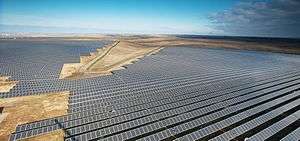Energy in Ukraine
Energy in Ukraine describes energy and electricity production, consumption and import in Ukraine. As an industry it is part of the Fuel and Energy Complex that combines smaller industries such as power generation and distribution, coal, oil and gas mining industries as well as transportation of resources. Ukraine's geographic position and proximity to Russia explain its importance as a natural gas and petroleum liquids transit country.
Approximately 3.0 trillion cubic feet (Tcf) of natural gas flowed through Ukraine in 2013 to Austria, Bosnia-Herzegovina, Bulgaria, Croatia, Czech Republic, Germany, Greece, Hungary, Moldova, Poland, Romania, Slovakia, and Turkey.[1]
Ukraine depends on Russia for its supplies of natural gas and oil (which are also produced domestically) while being a net-exporter of electricity and coal. Ukraine tries to diversify energy sources.[2]
Overview
| Population (million) |
Prim. energy (TWh) |
Production (TWh) |
Import (TWh) |
Electricity (TWh) |
CO2-emission (Mt) | |
|---|---|---|---|---|---|---|
| 2004 | 47.5 | 1,632 | 887 | 748 | 150 | 305 |
| 2007 | 46.4 | 1,597 | 949 | 693 | 164 | 314 |
| 2008 | 46.3 | 1,583 | 945 | 690 | 163 | 310 |
| 2009 | 46.0 | 1,343 | 894 | 487 | 147 | 256 |
| 2012 | 45.7 | 1,470 | 994 | 555 | 167 | 285 |
| 2012R | 45.6 | 1,427 | 993 | 448 | 166 | 281 |
| 2013 | 45.5 | 1,351 | 999 | 368 | 164 | 265 |
| Change 2004-2009 | -3.0% | -17.7% | 0.8% | -34.9% | -1.4% | -15.9% |
| Mtoe = 11.63 TWh, Prim. energy includes energy losses that are 2/3 for nuclear power[4]
2012R = CO2 calculation criteria changed, numbers updated | ||||||
Gas
Ukraine was the 6th highest importer of natural gas in 2009.[5] Ukraine stopped buying gas from Russia in 2015 due to the Russian presence in eastern Ukraine.[6] In disputes Russia has stopped gas delivery in 2006 and 2008. In 2009 80% of the European Union gas from Russia was delivered via Ukraine.
The largest domestic gas producer is UkrGasVydobuvannya, a subsidiary of the state-owned company Naftogaz. Private gas production companies in Ukraine are DTEK Oil&Gas, Ukrnaftoburinnya, Burisma, Smart Energy, Poltava Petroleum Company, Geo Alliance Group, and KUB-GAS.[7]
In 2019, Ukraine produced 20.7 billion cubic meters (bcm) of natural gas, while its annual domestic demand was 26 bcm. To satisfy domestic demand, Ukraine relies on gas imports, which totals approximately one third of its domestic demand.[8] To meet domestic demand, Ukraine plans to increase domestic natural gas output to 27 bcm. According to a report issued by the OECD, over 70% of the domestic gas production is covered by the Naftogaz subsidiary UkrGasVydobuvannya.[9]
Coal
Electricity
In 2014 total electricity production was 183 TWh, of which 8 TWh was exported to Europe; 88 TWh from nuclear, 71 TWh from coal, 13 TWh from natural gas, and 9 TWh from hydroelectricity. Electricity consumption was 134 TWh after transmission losses of 20 TWh, with peak demand at about 28 GWe. In 2015 electricity production fell to about 146 TWh largely due to a fall in anthracite coal supplies caused by the War in Donbass.[10][11]
Electricity production fell from 296 TWh in 1991 to 171 TWh in 1999, then increased slowly to 195 TWh in 2007, before falling again.[12]
In 2011 Ukraine joined the European Energy Community, however there has been slow progress on implementing European energy regulations.[13]
On 1 July 2019, a new wholesale energy market was launched, intended to bring real competition in the generation market and help future integration with Europe. The change was a prerequisite for receiving European Union assistance. It led to in increased price for industrial consumers of between 14% to 28% during July. The bulk of Energoatom output is sold to the government's "guaranteed buyer" to keep prices more stable for domestic customers.[13][14]
Nuclear power
Ukraine was 8th top nuclear electricity producer in 2009. 46.7% of domestic electricity generation was nuclear. This was the 2nd largest share, only France was higher.[15] The largest nuclear power plant in Europe is in Ukraine.
Energoatom (National Nuclear Energy Generating Company of Ukraine) is the state nuclear company founded in 1996. It has about 38,000 employees.
The 1986 Chernobyl disaster in Northern Ukraine was the world's most severe nuclear accident.
Lack of coal for Ukraine's coal-fired power stations due to the War in Donbass and a shut down one of the six reactors of the Zaporizhia Nuclear Power Plant lead to rolling blackouts throughout Ukraine from early till late December 2014.[16]
In 2018 Energoatom stated that electricity prices were too low to cover the cost of new nuclear fuel, and called for a price increase.[17]
Renewable energy
In 2017 Climate News Network reported that Chinese companies plan to spend $1bn in a solar power park in the nuclear disaster area in Ukraine.[18]
Finance
Ukraine signed a loan agreement in-principle for $3.65 billion with the China Development Bank in 2012, during President Viktor Yanukovich's term of office, contingent on the development of agreed development projects in the coal and gas sectors. However, by April 2017 Ukraine had not agreed any suitable projects due to a "lack of convergence in the positions of [Uglesintezgaz] and the energy ministry".[19]
Corruption
Corruption is one of the top problems in Ukraine, characterised as a systemic phenomenon, which exists in all sections and levels of the public administration.[2] Ukraine gets gas from Gazprom via third parties. Gazprom did not publish any reporting on anti-corruption programmes.[20]
In 2015 corruption allegations were made against Energoatom, Ukraine's nuclear power operator, with concerns raised by Prime Minister Arseniy Yatsenyuk.[21] In March 2016, Energoatom's assets and bank accounts were frozen by Ukrainian courts over allegedly unpaid debts, against which Energoatom is appealing.[22][23]
See also
| Wikimedia Commons has media related to Energy in Ukraine. |
References
- "International - U.S. Energy Information Administration (EIA)". eia.gov. Retrieved 9 October 2014.
- National Integrity System, Ukraine 2011 Transparency International
- IEA Key World Energy Statistics Statistics 2015, 2014 (2012R as in November 2015) + 2012 as in March 2014 is comparable to previous years statistical calculation criteria, 2013, 2012, 2011, 2010, Archived 2013-10-07 at the Wayback Machine 2009 , Archived 2009-10-12 at the Wayback Machine 2006 IEA October, crude oil p.11, coal p. 13 gas p. 15
- Energy in Sweden 2010 Archived October 16, 2013, at the Wayback Machine. Facts and figures. The Swedish Energy Agency. Table 8 Losses in nuclear power stations Table 9 Nuclear power brutto
- IEA Key statistics 2010
- "Naftogaz open letter: a year without gas imports from Russia". www.naftogaz.com. Retrieved 31 August 2018.
- Associations of Gas Producers of Ukraine
- , Kiev Post: Why Uraine Gas Production is So Low
- , OECD Report on SOE Reform in the Hydrocarbons Sector in Ukraine
- "Poroshenko: Ukraine increasing nuclear share to 60%". World Nuclear News. 17 February 2017. Retrieved 21 February 2017.
- "Poroshenko: Share of nuclear power grows to 60% amid blockade of trade with Donbas". UNIAN. 16 February 2017. Retrieved 21 February 2017.
- "Nuclear Power in Ukraine". World Nuclear Association. February 2017. Retrieved 21 February 2017.
- Prokip, Andrian (6 May 2019). "Liberalizing Ukraine's Electricity Market: Benefits and Risks". Wilson Centre. Retrieved 2 August 2019.
- Kossov, Igor (2 August 2019). "New energy market brings controversy". Kyiv Post. Retrieved 2 August 2019.
- p.187 of the IEA 2010 Publication on Ukrainian Energy
- Ukraine turns off reactor at its most powerful nuclear plant after 'accident', The Independent (28 December 2014)
Ukraine Briefly Cuts Power to Crimea Amid Feud With Russia Over NATO, New York Times (DEC. 24, 2014)
Coal import to help avoid rolling blackouts in Ukraine—energy minister, ITAR-TASS (December 31, 2014)
Rolling blackouts in Ukraine after nuclear plant accident, Mashable (Dec 03, 2014)
Ukraine to Import Coal From ‘Far Away’ as War Curtails Mines, Bloomberg News (Dec 31, 2014) - "Energoatom counts cost of regulatory changes". World Nuclear News. 19 March 2018. Retrieved 20 March 2018.
- Solar power to rise from Chernobyl's nuclear ashes Guardian 12 January 2017
- Karin Strohecker, Pavel Polityuk (14 April 2017). "Ukraine could miss out on up to $3.65 billion of China energy loans". Reuters. Retrieved 18 April 2017.
- 2011 report on oil and gas companies, Promoting revenue Transparency Transparency International 2011
- "Energoatom chief recalls highs and lows of first half-year". World Nuclear News. 12 August 2015. Retrieved 16 June 2016.
- "Continued Ukraine-Russia tensions over fuel". Nuclear Engineering International. 7 June 2016. Retrieved 16 June 2016.
- "Ex-head of Energoatom Derkach claims worst situation in sector in 25 years". Interfax-Ukraine. 23 May 2016. Retrieved 16 June 2016.

